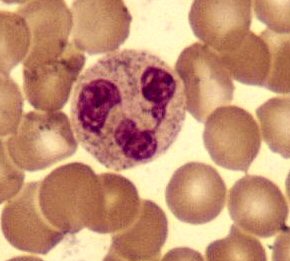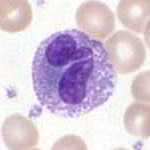Granulocyte

Granulocytes are a category of white blood cells which have granules in their cytoplasm.[1] They are also called polymorphonuclear leukocytes because of the shape of the nucleus, which has three segments. The term polymorphonuclear leukocyte often refers just to neutrophils, the most abundant of the granulocytes.
Granulocytes are released from the bone marrow. They operate by phagocytosis and other means.[2]
Types of granulocytes
There are three types of granulocytes, distinguished by their appearance under Wright's stain:
- Neutrophil granulocytes
- Eosinophil granulocytes
- Basophil granulocytes
Their names are derived from their staining characteristics; for example, the most abundant granulocyte is the neutrophil granulocyte, which has neutrally-staining cytoplasmic granules.
Other white blood cells which are not granulocytes are mainly lymphocytes and monocytes.
Related pages
- Agranulocytosis (not enough white blood cells in the blood)
References
- ↑ Hoffbrand A.V. Pettit J.E. and Moss P.A.H. 2005. Essential haematology 4th ed, Blackwell, Oxford. ISBN 0-632-05153-1
- ↑ Ernst J.D. and Stendahl O. (eds) 2006. Phagocytosis of bacteria and bacterial pathogenicity, Cambridge University Press. ISBN 0-521-84569-6 Website

